










April 27, 2006 - Post No. 66
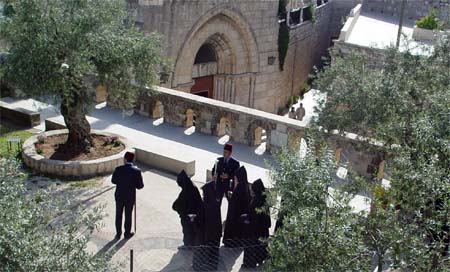
Today, we celebrated the Feast of the Annunciation at a very special site in Jerusalem, the orthodox church of the Tomb of Mary, next to the Garden of Gethsemane, at the base of the Mount of Olives across the Valley of Jehoshaphat from Old Jerusalem.
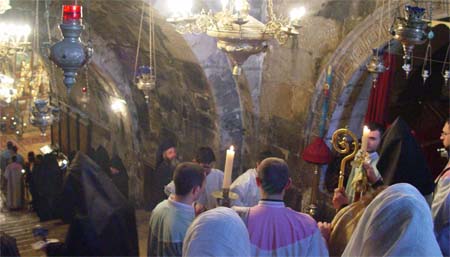
At 8:30 this morning, we gather once again at the main entrance to the monastery compound where we climb aboard two-mini buses that take us to the Tomb of Mary, an ancient sanctuary, well below the main road, and at the bottom of a long set of stairs. The oldest part of the Tomb of Mary dates back to the first century following the Resurrection, and the sanctuary was completed, carved from the native limestone, in several stages between the first and 13th centuries -- a 1200 year building project!
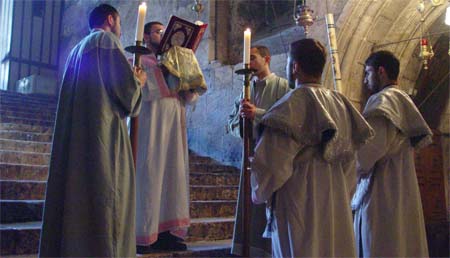
My guidebook for Jerusalem calls this one of the most mystical sites in the city, and it is very special to worship here this morning. The church has long been considered the final resting place for the Mother of Jesus, but of course, in both orthodox and catholic traditions, Mary doesn't rest here for very long, but is instead assumed into heaven by her son Jesus, who comes to resurrect her and lead her to her heavenly reward a seat place reserved for her to the right of her son, who himself is seated to the right of his father, at the Throne of Glory.
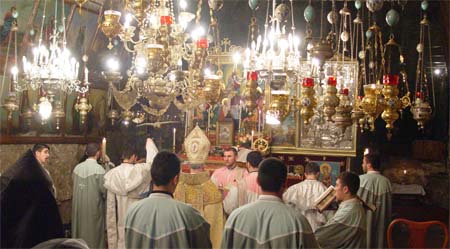
Today we gather to remember how "the angel of the the Lord came unto Mary, and she conceived by the Holy Spirit." Daron Serpazan, Bishop of the South of France, is the celebrant today, and attending the Badarak, the full contingent of monks and seminarians, as well as the last group of Armenian pilgrims from Yerevan, the capital of Armenia, lead by their parish priests.
The Armenian Orthodox share ownership of the Tomb of Mary with the Greek Orthodox, and they make great use of the space in their Badarak this morning, using the two side altars to great effect, along the long sweep of stairs (47 steps, altogether.)
It is a beautiful day today, and in the afternoon I decide to take advantage of the weather for a visit to the Temple Mount, or the site of the great Moslem mosque, the Dome of the Rock.
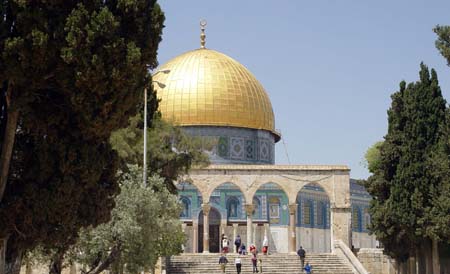
This is my third visit to Jerusalem, and it is the first time I have actually managed to visit the Temple Mount. Previously, the site has been closed to visitors, a form of political harassment of the Moslem population here, on the part of the Israelis in response to the Intefada.
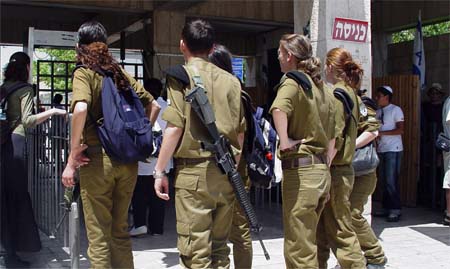
The Intefada, as you probably know, was the uprising of the Palestinian people against the Israelis under the leadership of the now deceased Palestinian President, Yasssir Arrafat -- generally seen now to have been a huge failure hurting the Palestinians as much or more than the Israelis, effectively discouraging tourism -- upon which most of the Palestinian economy depends -- for more than five years, and with other costly repercussions -- Israeli justifying the construction of the security barrier, for instance.
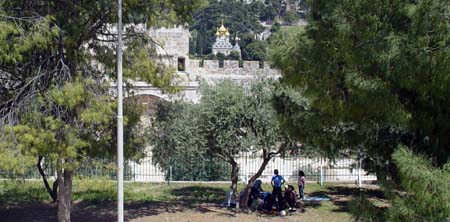
The size of the area of the Temple Mount, well above the rest of Old Jerusalem, is impressive. Most of the space is taken up with park lands, and there are several Moslem families enjoying picnics here during my visit, and dozens of small children having a super time playing in the compound

The two mosques on the Temple Mount are still closed to tourists, but there is plenty to see as I wander around the vast site. Here we see the smaller domed portico which was apparently constructed as a model for workmen in the building of the larger mosque, completed in 691 under the ruel of Caliph Abd el-Malik.
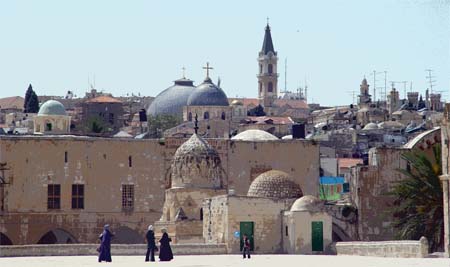
From the temple platform, it is easy to located the domes of the Holy Sepulchre along with the bell towers and minarets of the old city.
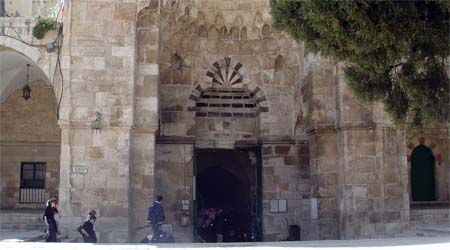
There is only one way for tourists to enter the area surrounding the Dome of the Rock, through the main gate beside the Wailing Wall, but there are several gates to choose from when it comes time to leave. I am drawn to the Cotton Merchants' gateway, leading into the myriad of covered souqs in the old city.
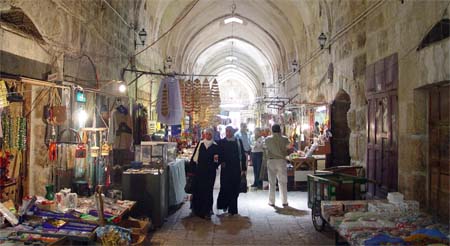
One final stop before calling it a sight seeing day, the Lutheran Church of the Redeemer, located in the heart of the Christian Quarter, steps away from the Basilica of the Resurrection. This magnificent building was completed in 1898 and is the third Christian church to be built on the site, the first going back to the fifth century of the Common Era.
